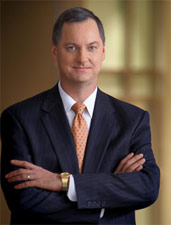
Unprecedented economic turmoil challenged the Federal Reserve System and the Federal Reserve Bank of Chicago in 2008. Housing markets deteriorated. Employment and consumer confidence plummeted, and credit markets experienced large-scale disruptions. The Fed responded aggressively to stem the tide. We looked at problems in new ways and responded quickly to a rapidly changing financial services industry.
The Bank's new vision statement helped guide our efforts. It emphasizes the importance of talented staff members collaborating with one another as well as with customers and stakeholders. It reinforces our commitment to work in the public interest to foster a strong economy and stable financial system. Approaching our jobs with this vision in mind helped us deal with not just the financial crisis but also with restructuring our check-processing operations, offering high-quality currency services, and helping banks access our electronic payment products more effectively.
As we navigated through these challenges, our boards of directors in Chicago and at the Detroit Branch made important contributions. Their counsel on our operations and insight into regional business conditions proved to be especially valuable as the year progressed. They asked tough questions, provided thoughtful feedback, and shared useful information on economic conditions.
This year's annual report looks at other ways we gather and share information on economic and financial conditions: our conference program. The report outlines some of the findings of important conferences we sponsored in 2008. As always, we leveraged our unique ability to convene top experts in diverse fields. As the financial crisis unfolded, these experts discussed timely topics such as credit market turmoil, the state of the automotive industry, risk management, the economic forecast, preventing home foreclosures and promoting financial education.
These conferences foster an informed debate on important public policy issues facing the economy and banking system. They provide new perspectives and contribute to the development and dissemination of high-quality research. The summary that follows offers a glimpse into the concerns and policy solutions that surfaced as the year progressed. I hope you find it informative.
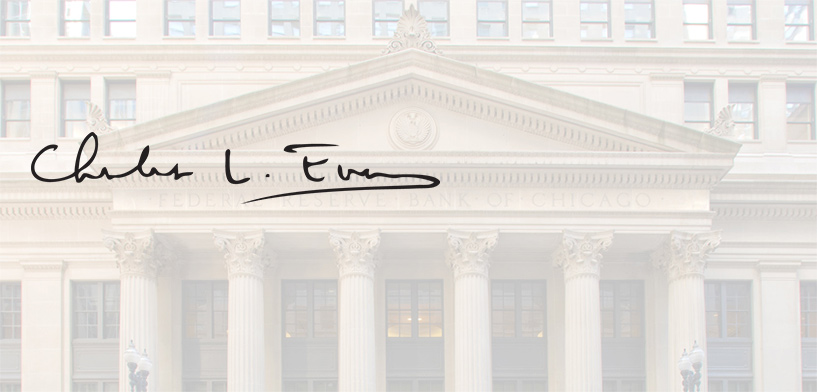
Charles L. Evans
President and Chief Executive Officer
As 2009 began, the U.S. economy was in the midst of a serious recession. Real gross domestic product (GDP) fell sharply late in 2008 and apparently again in early 2009. These declines occurred despite aggressive moves by the Federal Reserve that lowered the federal funds rate to near zero and approximately tripled the size of its balance sheet. Since the beginning of the recession, 4.3 million jobs have been lost, with the unemployment rate reaching 8.1% in February 2009.
Weak labor markets and the early-year increases in energy prices held back growth in real incomes in 2008. This, along with strains in financial markets and substantial declines in household wealth, led to a large drop in consumer spending over the second half of the year. Residential investment continued to deteriorate throughout 2008, with construction, new home sales and home prices all declining further. Business spending also contracted sharply in the second half of 2008, and weakening foreign activity and the higher U.S. dollar reduced the strong contribution to growth from net exports that had occurred in the first half of the year.
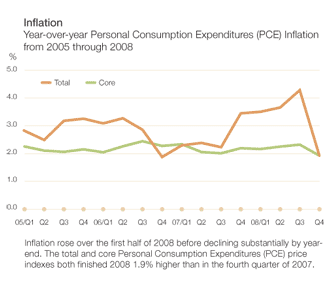 Measures of consumer price inflation decreased in 2008 from the prior year. Inflationary pressures eased substantially over the course of the year, reflecting falling prices for energy and other commodities later in the year, declining import prices, and increases in resource slack due to diminished economic activity.
Measures of consumer price inflation decreased in 2008 from the prior year. Inflationary pressures eased substantially over the course of the year, reflecting falling prices for energy and other commodities later in the year, declining import prices, and increases in resource slack due to diminished economic activity.
Responding to the Credit Crisis
In 2008, the tightening of credit conditions began to weigh on economic activity. Problems with several major financial institutions intensified market participants' concerns about potential losses on a range of assets as well as the ability of counterparties to meet contractual obligations. This further increased risk aversion and sparked a "flight to quality" toward traditionally safe assets such as U.S. Treasuries. Toward the end of 2008, a further pullback in risk-taking occurred, spurred by further disruptions in short-term funding markets as well as a more pessimistic outlook for the economy. This led to even lower equity prices, higher risk spreads, and tighter credit markets, all of which fed back into further declines in real and financial activity.
In response to these extraordinary events, the Fed made large adjustments to its traditional monetary policy instrument — the federal funds rate. At the Federal Open Market Committee (FOMC) meeting in December 2008, the federal funds rate was essentially cut to zero — 300 basis points lower than where it was at the start of the year. Although the corresponding injections of liquidity helped credit conditions, it became clear that further extensions of central bank liquidity would be necessary to facilitate market functioning. These included increasing the maturity of discount window loans from overnight to 90 days and the expansion of the Term Auction Facility (TAF) to provide loans through auctions in order to overcome stigma associated with discount window borrowing.
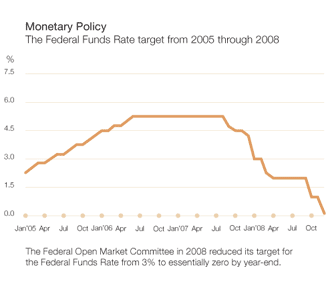 Furthermore, the sudden demise of several non-depository institutions led to the creation of a number of new lending facilities under emergency powers granted by the Federal Reserve Act. These measures were first aimed at broker-dealers, who have a large-scale presence in short-term funding markets. Subsequently, lending facilities were introduced to help work through disruptions in the money market mutual fund and commercial paper markets. The Fed also began to purchase debt and mortgage-backed securities issued by government-sponsored enterprises (GSEs) to support the flow of credit in mortgage markets.
Furthermore, the sudden demise of several non-depository institutions led to the creation of a number of new lending facilities under emergency powers granted by the Federal Reserve Act. These measures were first aimed at broker-dealers, who have a large-scale presence in short-term funding markets. Subsequently, lending facilities were introduced to help work through disruptions in the money market mutual fund and commercial paper markets. The Fed also began to purchase debt and mortgage-backed securities issued by government-sponsored enterprises (GSEs) to support the flow of credit in mortgage markets.
Moving Forward
The Fed has not been alone in dealing with this crisis, as both the FDIC and the U.S. Treasury have taken numerous actions aimed at addressing difficulties in financial markets. These actions, along with market forces, will help move the U.S. economy back toward financial stability. Still, it could take some time before financial markets function in a manner that noticeably facilitates economic activity. Consequently, real GDP is likely to decline in the first half of 2009, before stabilizing later in the year, with important support coming from monetary and fiscal policy. However, the unemployment rate is likely to rise into 2010 as it could take some time for the rebound in activity to be strong enough to close resource gaps.
Although futures markets expect some rise in the prices for energy and other commodities, resource slack should result in another reduction in inflation in 2009 and a further edging down in 2010. Over the longer run, overall inflation is expected to average somewhere in the range of 2%, which is a rate consistent with price stability. However, there is notable risk that inflation will run a good deal below this range in the medium term.
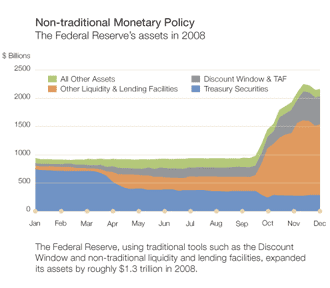 In the coming year, several new policy tools will be employed, including the Term Asset-Backed Security Loans Facility (TALF), a joint program with the Treasury. The first TALF lending is aimed at reducing funding pressures in the student, consumer, and small business asset-backed securities (ABS) markets. Subsequent extensions are likely to address pressures in other ABS markets such as commercial mortgage-backed securities. The Fed has also begun buying longer-term Treasury securities to reduce borrowing costs for a range of longer-term instruments and expanded its purchases of GSE securities. However, as economic activity recovers and financial conditions normalize, the use of such tools will have to be scaled back, the size of our balance sheet will have to be reduced, and the FOMC will return to its traditional focus on the federal funds rate.
In the coming year, several new policy tools will be employed, including the Term Asset-Backed Security Loans Facility (TALF), a joint program with the Treasury. The first TALF lending is aimed at reducing funding pressures in the student, consumer, and small business asset-backed securities (ABS) markets. Subsequent extensions are likely to address pressures in other ABS markets such as commercial mortgage-backed securities. The Fed has also begun buying longer-term Treasury securities to reduce borrowing costs for a range of longer-term instruments and expanded its purchases of GSE securities. However, as economic activity recovers and financial conditions normalize, the use of such tools will have to be scaled back, the size of our balance sheet will have to be reduced, and the FOMC will return to its traditional focus on the federal funds rate.
Source for all charts: Haver Analytics
*This essay reflects information available as of March 27, 2009.
Throughout 2008, the economy and financial system experienced extraordinary turbulence. The slumping U.S. housing market and rising delinquencies on subprime mortgages triggered a financial crisis that quickly spread to a wide range of asset classes, markets, and global financial institutions. In September, the crisis hit its boiling point. Lehman Brothers filed for bankruptcy, Merrill Lynch and Washington Mutual were acquired by other financial institutions, Goldman Sachs and Morgan Stanley reorganized as bank holding companies, and the Federal Reserve provided loans to AIG.
In the days following these events, financial regulators from around the world gathered at the Federal Reserve Bank of Chicago to discuss how banking rules would need to change. The timing of this conference brought an exceptional relevance to the proceedings. A group of financial reporters closely covered the conference's discussions and speeches. Participants filled the halls discussing recent events with counterparts from other countries. They frequently phoned colleagues at home to discuss the latest developments. The conference participants were at the forefront of discussions of how to find the right balance between bank-based and market-based financial intermediation.
The meeting was the Chicago Fed's annual International Banking Conference, co-sponsored by the European Central Bank. It is one of many examples of how the Chicago Fed fosters an informed public policy debate on important economic and financial issues. We frequently leverage our ability to convene experts in diverse fields to address major public policy questions. These conferences inform our own efforts to promote sustainable economic growth and price stability and help us develop and disseminate high-quality research. They also create and advance the intellectual framework needed for future policy discussions and support our bank supervision efforts.
In this essay, we highlight some of our conference discussions with experts from the public and private sectors during 2008. The questions addressed at these meetings related to a broad range of issues, including the global regulatory environment and how to make regulation more effective, the impact of the recession on community banks, improving banks' risk management practices, preventing home foreclosures and educating the public about available resources, improving household budget management, how private equity is adapting to the credit crunch, and the outlook for the auto industry.
What Regulatory Changes Are Needed?
Participants at the International Banking Conference in September identified several factors contributing to the asset-price bubble and ensuing credit market turmoil and proposed a range of regulatory changes that might prevent future crises. Conference participants debated the factors contributing to the asset-price bubble, with many blaming a combination of accommodative monetary policy, financial engineering, asset complexity, lack of adequate transparency, and questionable information provided by rating agencies. Looking forward, the conference participants proposed adjustments to regulatory policy ranging from minor tweaks to a major overhaul of existing capital requirements and regulatory structures. There was also significant debate about the future role of market discipline in influencing the behavior of both consumers and private companies.
Ideas for possible regulatory changes also surfaced frequently at a November conference titled, "The Capital Markets: After the Bubble." This event featured banking and securities regulators and risk management experts from the U.S. and abroad, including representatives of international and U.S. banking regulatory agencies, the Securities and Exchange Commission, and the Commodity Futures Trading Commission. The presenters agreed significant changes are needed in various parts of international capital markets, deal structures, incentives, and governance. This conference also addressed new proposals on covered bonds and re-consolidation issues for structured investment vehicles and asset-backed commercial paper. Participants generally agreed that while these markets and products played a critical role in causing the global financial crisis, they are also critical to economic stability and recovery.
Many of those in attendance at the capital markets conference focused on securitizations and the ratings, governance, and transparency associated with those transactions. Since the breakdown of this market is a major cause of the financial crisis, its future structure is a key to recovery. And some of the smaller markets that have collapsed during this crisis, such as the one for auction rate securities, are unlikely to return in their previous form.
How Have Community Banks Been Affected by the Tumultuous Economic Environment?
The Chicago Fed hosted the Community Bankers Symposium in November, an event that attracted officers and directors from community banks and bank holding companies throughout the Midwest, as well as state and federal bank regulators. Panelists agreed that the current environment offers both challenges and opportunities. Bankers and regulators face the challenges of how best to assess risk management processes and how to value certain underlying assets, which serve as collateral for community bank loans. As for opportunities, some community banks are seeing increased loan demand as larger banks de-lever and shrink their balance sheets. From a deposit perspective, banks are seeing opportunities to raise funds through the Internet and because of a general flight to safety, with banks large and small benefiting from changes to the deposit insurance program.
Conference participants said that many community banks are going back to the basics, by creating underwriting standards with a focus on repayment capacity, establishing strong controls to ensure adherence to established policies, and ensuring that incentives are aligned with risk.
Finally, this conference emphasized the importance of community banking in providing fair and equal access to credit for consumers and small business proprietors.
What Has the Credit Crisis Revealed About Risk Management?
With risk management in banking becoming more complex and sophisticated, the Chicago Fed's Supervision and Regulation Department partnered with DePaul University's Center for Financial Services in April of 2008 to sponsor a conference on the issue. It brought together bankers, supervisors and academics to focus on comprehensive risk management, also known as enterprise risk management (ERM).
One panel discussed how the blurring of credit and capital markets has complicated risk management. In recent years, more banks have adopted the "originate-to-distribute" model, under which they originate loans for the sole purpose of selling them to others. Now loans that were traditionally credit assets are common in trading books, and the difference between credit risk and market risk has become increasingly less distinct. Jeff Phillips of BMO Capital Markets Group discussed how this had contributed to recent financial turmoil. Kathryn Dick from the Office of the Comptroller of the Currency and Coryann Stefannson from the Federal Reserve Board examined how the market blurring has affected bank supervision. The panel discussion following these presentations centered on the use of credit ratings by investors and regulators and how these ratings might be improved.
Finally, the conference included keynote addresses from Eric S. Rosengren, president of the Federal Reserve Bank of Boston, and Craig S. Donohue, chief executive officer of the CME Group. In light of recent difficulties in pricing complex financial instruments, Rosengren questioned whether some instruments should be more standardized or possibly moved from dealer markets to exchange-traded instruments. Similarly, Donohue advocated a more centralized and transparent execution system for these products.
Federal Reserve Chairman Ben Bernanke also spoke about risk management at the Chicago Fed's annual Bank Structure Conference in May of 2008. This gathering is the Chicago Fed's longest-running conference and traditionally draws top leaders in the nation's financial industry. Past speakers include FDIC Chairman Sheila Bair, SEC Chairman Christopher Cox, and Treasury Secretary John Snow. Joining Chairman Bernanke last year was James Lockhart, director of the Office of Federal Housing Enterprise Oversight, and James Rohr, chairman and CEO of the PNC Financial Services Group.
Chairman Bernanke focused his remarks on risk management lessons from the credit market turmoil, explaining that, "The turmoil in credit markets underscores some important principles for bank risk management, including the value of proper risk identification and measurement, the need for robust and objective valuation methods, the importance of preparing for liquidity disruptions, and the critical role of strong oversight by senior managers." He also noted that the role of the Fed and other supervisors is no less critical. "[It] is clear that supervisors must redouble their efforts to help organizations improve their risk-management practices," Bernanke said. "Accordingly, we have increased supervisory attention to this issue. ... We are also considering the need for additional or revised supervisory guidance regarding various aspects of risk management, including further emphasis on the need for an enterprise-wide perspective when assessing risk. ... We are also seeking to promote better disclosures by banking institutions with the goal of increasing transparency, thereby strengthening market discipline."
What Can Banks, Regulators, and Community Organizations Do to Prevent Home Foreclosures?
The Bank convened the Regional Home Ownership Preservation Initiative (RHOPI) with the Chicago Community Trust and NHS of Chicago. Individuals representing almost 100 organizations worked to reach recommendations and action steps late in 2008 to address the high rates of foreclosure and resulting vacant property in the metropolitan area. Other key topics included homeowner counseling, legal assistance, refinancing, and loss mitigation issues. Many of these organizations are now implementing recommendations from this forum. Participants agreed that preventing further foreclosures was an important goal, because a large proportion of loans already modified to prevent or remedy default have also defaulted. An even more difficult issue is the many vacant properties resulting from foreclosures in our region. A group of RHOPI participants is working to channel federal and other relief to the hardest hit areas of the Chicago metro area.
During the past year, the Chicago Fed also sponsored numerous other discussions about the foreclosure crisis and the resources available to local communities to deal with housing issues. Among these forums were a symposium co-sponsored by the Iowa and Davenport Civil Rights Commissions on "Fair Lending/ Fair Housing in the Foreclosure Crisis," conferences co-sponsored by the University of Wisconsin Extension and the Wisconsin Housing and Economic Development Authority to address the problems wrought by foreclosures in that state, and a conference at the Chicago Fed's Detroit Branch on "Saving the American Dream: Preventing Foreclosure & Preserving Homeownership." At the meeting in Detroit, discussion focused on both mortgage foreclosures and tax foreclosures. With many Michigan residents facing tax foreclosures, participants agreed more communication is needed with the public about the problem. Toward that end, they formed a task force to inform consumers about resources available to those facing a tax foreclosure.
In addition, at the Bank Structure Conference in May, financial regulators discussed their efforts to provide delinquent homeowners with information to work with mortgage holders and evaluate their options. A representative from the Hope Now Alliance also described its work with counselors, mortgage companies, investors, and financially constrained homeowners, all designed to enable residents to stay in their homes.
What Types of Programs Help People to Understand and Manage Their Finances?
The Chicago Fed helps consumers learn how to manage their personal finances. In challenging economic times, knowledge of subjects like budgeting, saving, and using credit wisely is especially important. Toward that end, we have increased the number of participants in our Money Smart programs in central Illinois, Chicago, Indiana, Michigan, Iowa, and Wisconsin. Approximately 1,200 partners took part in these Money Smart Weeks in 2008, including local community groups, financial institutions, not-for-profit organizations, businesses, schools, libraries, local and national government agencies, and media personalities. They worked together to bring roughly 2,100 seminars, classes, and special events on personal finance topics to thousands of consumers. Among the Money Smart Week Chicago events:
- Nearly 400 people attended an event sponsored by the Illinois Financial Planners Association. The audience heard from author and financial expert Terry Savage and had the opportunity to meet one-on-one with certified financial planners.
- Harold Washington College hosted 500 students and community members for its second-annual financial literacy fair, featuring more than a dozen Money Smart partners and topics.
- The Bank and Visa, Inc. co-sponsored a "webinar" on ways to bring financial education to consumers.
What is the Outlook for the Auto Industry?
With about one-third of the nation's new motor vehicles produced in the Chicago Fed's five-state region, we have a deep interest in the health of the auto industry. In June of 2008, the Automotive Outlook Symposium at our Detroit Branch brought together more than 90 economists and analysts from the industry, academia, and government. The group discussed the near-term outlook from the perspectives of U.S. auto manufacturers, heavy truck producers, auto dealers, and parts suppliers.
David Andrea, vice president of the Original Equipment Suppliers Association, predicted that bankruptcies among the auto parts suppliers will continue in the near term. Yet, looking past 2009, he cited diversification into non-automotive work and increasing globalization as reasons for optimism. In 2007, 68.6 million automobiles were sold across the world, and Andrea predicted the volume to increase to 87.3 million by 2014.
The auto industry was also the topic of discussions at the Chicago Fed's annual Economic Outlook Symposium in December 2008. This meeting was held two weeks after U.S. auto executives appeared at Congressional hearings on the future of the industry and amid growing uncertainty about the industry. Conference participants debated whether the industry's short- and long-term struggles would be best addressed through normal bankruptcy or a government-assisted restructuring outside the court system. Speaking about the short-term market dynamics, William Shearin, formerly with Chrysler LLC, said that composite measures of consumers "ability to buy" and "willingness to buy" had deteriorated significantly in the previous 12 months. In a forecast survey associated with the conference, economists forecasted light vehicle sales to fall further in 2009. But Shearin did give one reason to be optimistic about sales once credit markets normalize: The average age of used vehicles has increased to a historically high 6.5 years, suggesting that many vehicle owners will want to replace their aging vehicles as soon as economic conditions allow them to do so.
Finally, the ownership structure of the auto industry was the focus of a presentation in 2008 at a conference sponsored by the Federal Reserve System's Private Equity Merchant Banking Knowledge Center, which is based at the Chicago Fed. The July event brought together private equity professionals, banking supervisors, academics and bankers to discuss how the financial crisis has dramatically altered the landscape for private equity, particularly in the buyout sector. In the first luncheon keynote address, Jacques Nasser, managing director of One Equity Partners and formerly president and CEO of the Ford Motor Company, explored private equity investment strategies that target the auto industry. Each of the three segments of the auto industry (manufacturers, suppliers, and dealers) has significant structural and operational weaknesses that could present opportunities for private equity firms, he said. Nasser also proposed a broader and longer-term strategy — with investments in a range of new technologies that would benefit energy security and environmental protection while generating profits for both the automotive sector and the private equity industry at large.
How Are Equity Investment Markets Adapting to the Global Credit Crunch?
At the conference mentioned directly above, Meredith Coffey from the Loan Syndication and Trading Association described how supply and terms in the so-called "leveraged lending" market have become much less favorable for private equity firms. As a result, merger and acquisition lending has fallen sharply, with leveraged buyouts hit hardest. Private equity firms had become accustomed to a stream of increasingly large buyout deals, with their buying power supported by the availability of inexpensive leverage. Now that this access to credit has largely dried up, some private equity firms have altered their investment strategies.
According to Avy Stein, Willis Stein Partners, such new strategies include the middle market, minority (non-controlling) investments, emerging markets, non-equity instruments, and distressed assets. Private equity investors see opportunities in the U.S. banking sector, as well as the auto industry, in the current weak environment.
Finally, the prospect of lower returns on private equity investments going forward will affect a wide range of investors. These include institutional investors such as pension funds and university endowments, which in recent years have been increasing their use of private equity, among other nontraditional investments. In view of recent experience, it is also very likely that institutional investors will change their investment strategies to favor a more traditional, lower-risk investment mix once more.
Conclusion
In this essay, we have shared some examples of the issues addressed at conferences hosted by the Chicago Fed in 2008. With the credit crisis still to be resolved and with new public policy issues regularly emerging, the Chicago Fed will continue to leverage its ability to convene the best minds from the Seventh District, the nation, and abroad to discuss appropriate ways forward in the face of uncertainty.
This essay was a collaborative effort, with contributions from many Chicago Fed staff members including: Mike Berry, Cathie Bourke, Adrian D'Silva, Emily Engel, Doug Evanoff, Harry Ford, Brian Gordon, William Mark, Michael Munley, Mark Kawa, Helen Koshy, Cathy Lemieux, Michael Plaskett, William Strauss, Doug Tillett, Steven VanBever, Dan Wassmann and Alicia Williams.










